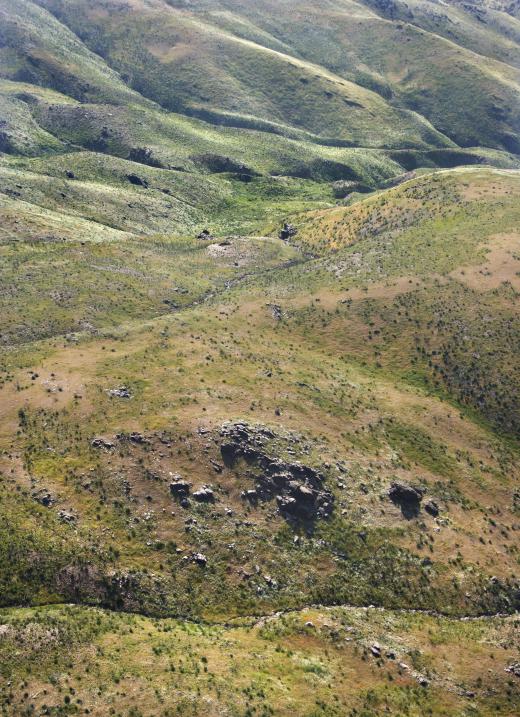What is a Contour Map?
A contour map, sometimes called a topographic map, is a representation of a three-dimensional feature using contour lines on a flat surface. The map shows a bird's-eye view and allows people to visualize the hills, valleys, and slopes that are being mapped. It usually includes the title, the scale, contour interval, the legend, and whether it uses latitude and longitude or Universal Transverse Mercator (UTM) coordinates. This type of map can be useful in many activities, including camping, urban planning, meteorology, and geologic studies.
Contour lines are the main component of a contour map. They connect points of equal value, such as elevation, to create the asymmetrical circles and curved lines that make up the map. The cartographic standard is for contour lines to be brown in color.

The way that contour lines on a flat map can be used to show a three-dimensional surface can be understood if one imagines a mountain being sliced horizontally with a flat sheet of paper. The outline of the mountain as it intersects the sheet of paper at a particular same elevation would form a contour line. A contour map essentially takes horizontal slices of the mountain at specific intervals and shows the outlines of the slices on one sheet of paper.
Contour lines on the map always have the same difference in value, called the contour interval. The interval is chosen by the person producing the map. For example, each line could represent 10 feet (3 m) of altitude. The interval stays constant, so a person reading the contour map can estimate the value of any point between two contour lines.
A contour map also contains index contours to make it easier to interpret the map. The index contour is a thicker contour line that is labeled in several spots with the value of the line. For instance, there might be unlabeled contour lines for every 10 feet (3 m) in elevation, but every 50 feet (15 m) could be a thicker line with the elevation labeled. There generally are four contour lines between each contour index unless there is a change in slope, in which case there would be more than one contour line for the same elevation.
There are several geographic features that can be visualized if one understands what a contour map shows. If the contour lines are close together, it indicates steep gradient, such as on a hill or mountain. A map with evenly spaced contour lines means that the slope is constant, and where there are few contours, it is relatively level ground. A closed circle signifies a hill, and a closed circle with tick marks is used to signify a depression. Contour lines will make a "V" shape that will point uphill along a stream on a map.
Although a contour map is often used to map geographical features such as elevation, it can have other purposes as well. For example, in meteorology, this type of map often is used to show temperature or precipitation. Another example is when geologists use contour maps to show the depth of a lake or even underground features.
AS FEATURED ON:
AS FEATURED ON:











Discussion Comments
I think I'm mostly familiar with contour weather maps. I know, in that context, the lines are called isobars, and the closer together the isobars are, the higher the winds are in that area.
I do some weather report writing for my newspaper (backed up by the real meteorologists at the National Weather Service), so I have to know how to read those contour maps -- at least I need to get the basics of what's going on. I can't tell you about all the intricacies, like hodographs and that kind of thing, but I can look at them and get a general idea of what the weather will be like the next day.
I learned to read a contour (or terrain) map in JROTC in high school. That was actually a big part of our classwork, and we had these little square plastic protractors that we used to plot map points, and to find points on the map.
It wasn't easy to learn to read that map, but I kept at it and I finally learned to do it with some proficiency. That's been more than a few years ago, but I'd like to think that, with a little study and some work, I could pick up the skill again. You never know when knowing how to read a contour map might come in handy.
Post your comments